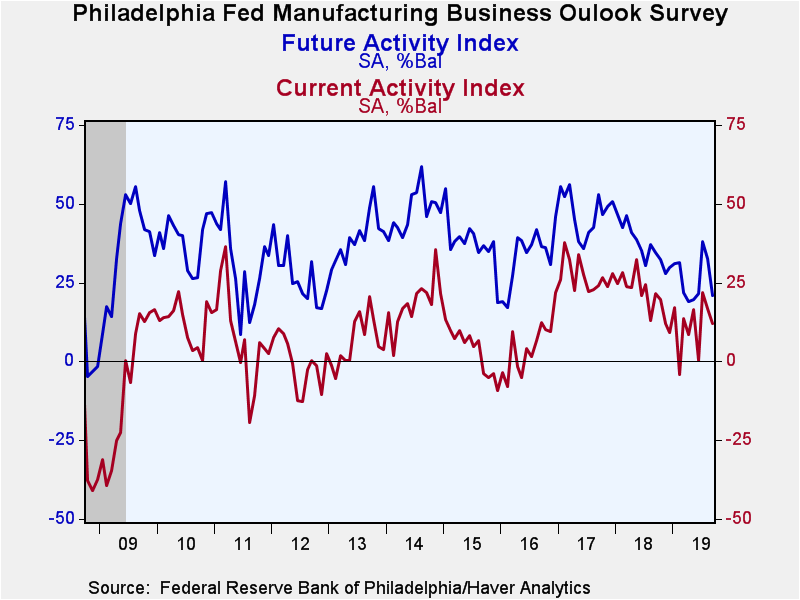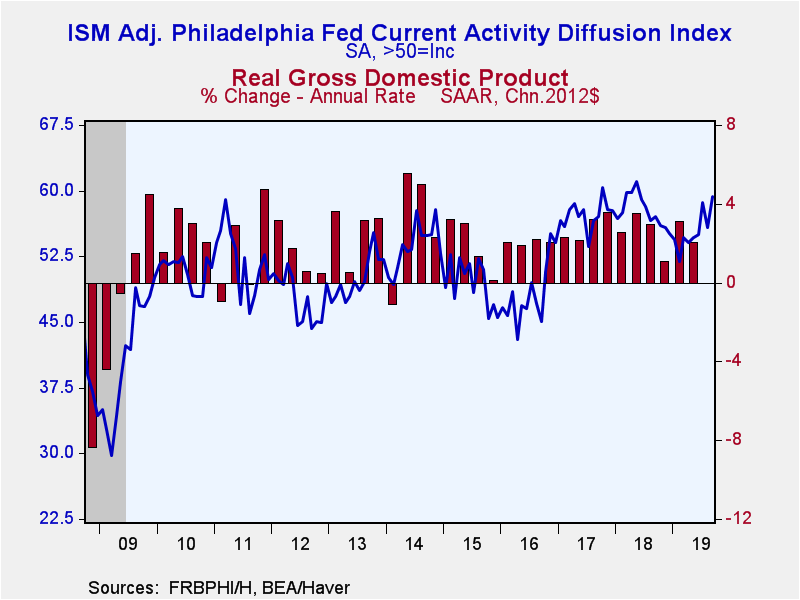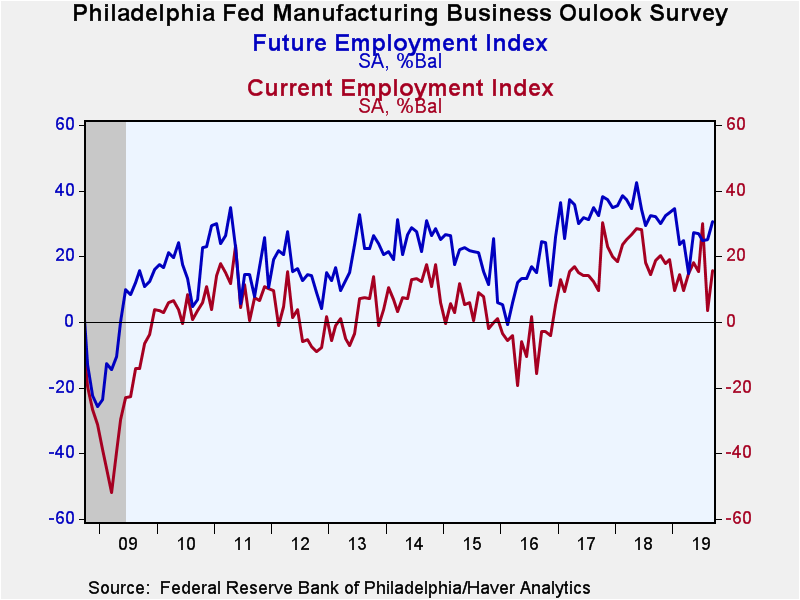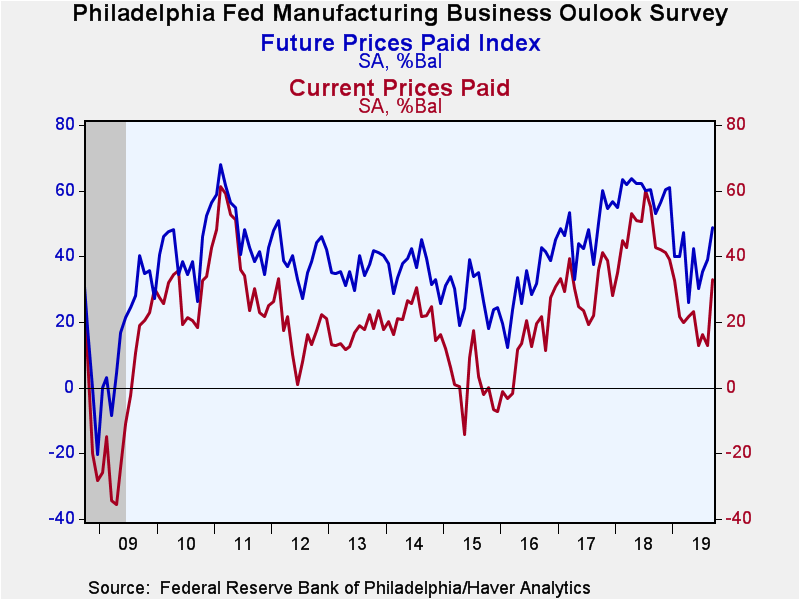 Global| Sep 19 2019
Global| Sep 19 2019Philadelphia Fed Manufacturing Survey Indicates Continued Growth
by:Tom Moeller
|in:Economy in Brief
Summary
The Federal Reserve Bank of Philadelphia reported that its General Factory Sector Business Conditions Index declined to 12.0 in September following a reading of 16.8 in August. It was the lowest figure in three months, but was higher [...]
The Federal Reserve Bank of Philadelphia reported that its General Factory Sector Business Conditions Index declined to 12.0 in September following a reading of 16.8 in August. It was the lowest figure in three months, but was higher than the readings earlier in the year. An index of 11.5 had been expected in the Action Economics Forecast Survey. These figures are diffusion indexes where readings above zero indicate expansion. The percentage of firms reporting an improvement in business activity eased to 28% in September from 37% in August. The percentage reporting weaker conditions declined to 16% from 21%.
Haver Analytics constructs an ISM-Adjusted General Business Conditions Index. It improved to 59.3 this month, the highest level since May 2018 and higher than the February low of 51.9. The index reached an expansion high of 61.1 in May of 2018. Over the past twenty years, there has been a 61% correlation between the ISM-adjusted Philadelphia Fed Index and q/q real GDP growth.
Despite the decline in the General Activity Index, the performance of the underlying series mostly improved m/m. The shipments and delivery times measures rose, the latter indicating a sharp slowing of delivery speeds since April. The unfilled orders index rose to nearly an expansion high and the inventories measure also increased. Working the other way, the new orders measure eased modestly.
The employment index reversed much of its August weakening, though it remained below its October 2017 high. A steady 25% of respondents reported an increased level of hiring, while a greatly reduced nine percent of respondents reported a deterioration. During the last twenty years, there has been a 77% correlation between the jobs index and the m/m change in factory sector employment. The average workweek measure rose slightly following a sharp decline during August. It remained well below its May 2018 high.
The index of prices paid increased to the highest level in nine months and was greatly improved following deterioration early this year. An increased 38% of respondents reported paying higher prices while a greatly lessened five percent reported lower prices. The index of prices received surged to a six-month high as 26% of respondents reported price increases versus a low of 10% in June.
The Philadelphia Fed also constructs indexes of future activity. The General Business Conditions series declined to a four-month low and was sharply below its 2017 high. The future new orders, shipments and inventories measures fell while unfilled orders and delivery times rose. The employment measure also rose. The employment index also increased to the highest level since January. The expected prices paid index surged to a nine-month high.
The survey panel consists of 150 manufacturing companies in the third Federal Reserve District (which consists of southeastern Pennsylvania, southern New Jersey and Delaware). The diffusion indexes represent the percentage of respondents indicating an increase minus the percentage indicating a decrease in activity. The ISM-adjusted figure, calculated by Haver Analytics, is the average of five diffusion indexes: new orders, shipments, employment, delivery times and inventories with equal weights (20% each). Each ISM-adjusted index is the sum of the percent responding "higher" and one-half of the percent responding "no change."
The figures from the Philadelphia Federal Reserve dating back to 1968 can be found in Haver's SURVEYS database. The expectation from the Action Economics Forecast Survey is available in AS1REPNA.
| Philadelphia Fed - Manufacturing Business Outlook Survey (%, SA) | Sep | Aug | Jul | Sep'18 | 2018 | 2017 | 2016 |
|---|---|---|---|---|---|---|---|
| General Factory Sector Business Conditions | 12.0 | 16.8 | 21.8 | 21.4 | 21.1 | 27.3 | 4.9 |
| ISM-Adjusted Business Conditions | 59.3 | 55.8 | 58.6 | 57.0 | 57.7 | 57.3 | 48.2 |
| New Orders | 24.8 | 25.8 | 18.9 | 20.6 | 21.0 | 25.3 | 5.0 |
| Shipments | 26.4 | 19.0 | 24.9 | 22.0 | 22.8 | 26.8 | 6.9 |
| Unfilled Orders | 17.6 | 9.1 | 3.7 | 11.3 | 7.1 | 11.9 | -5.6 |
| Delivery Time | 11.6 | 9.3 | 15.0 | 10.3 | 9.5 | 10.6 | -4.6 |
| Inventories | 21.8 | 8.7 | 8.1 | 13.9 | 7.4 | 2.9 | -9.6 |
| Number of Employees | 15.8 | 3.6 | 30.0 | 18.6 | 21.6 | 16.1 | -5.6 |
| Average Workweek | 13.0 | 6.8 | 23.0 | 14.6 | 15.9 | 14.9 | -5.4 |
| Prices Paid | 33.0 | 12.8 | 16.1 | 42.6 | 46.4 | 30.4 | 13.5 |
| Expectations - General Business Conditions; Six Months Ahead | 20.8 | 32.6 | 38.0 | 34.5 | 36.9 | 47.1 | 33.7 |
Tom Moeller
AuthorMore in Author Profile »Prior to joining Haver Analytics in 2000, Mr. Moeller worked as the Economist at Chancellor Capital Management from 1985 to 1999. There, he developed comprehensive economic forecasts and interpreted economic data for equity and fixed income portfolio managers. Also at Chancellor, Mr. Moeller worked as an equity analyst and was responsible for researching and rating companies in the economically sensitive automobile and housing industries for investment in Chancellor’s equity portfolio. Prior to joining Chancellor, Mr. Moeller was an Economist at Citibank from 1979 to 1984. He also analyzed pricing behavior in the metals industry for the Council on Wage and Price Stability in Washington, D.C. In 1999, Mr. Moeller received the award for most accurate forecast from the Forecasters' Club of New York. From 1990 to 1992 he was President of the New York Association for Business Economists. Mr. Moeller earned an M.B.A. in Finance from Fordham University, where he graduated in 1987. He holds a Bachelor of Arts in Economics from George Washington University.










